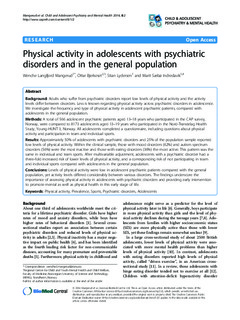| dc.contributor.author | Mangerud, Wenche Langfjord | |
| dc.contributor.author | Bjerkeset, Ottar | |
| dc.contributor.author | Lydersen, Stian | |
| dc.contributor.author | Indredavik, Marit Sæbø | |
| dc.date.accessioned | 2015-09-29T11:18:39Z | |
| dc.date.accessioned | 2015-10-15T07:54:11Z | |
| dc.date.available | 2015-09-29T11:18:39Z | |
| dc.date.available | 2015-10-15T07:54:11Z | |
| dc.date.issued | 2014 | |
| dc.identifier.citation | Child and Adolescent Psychiatry and Mental Health 2014, 8(2) | nb_NO |
| dc.identifier.issn | 1753-2000 | |
| dc.identifier.uri | http://hdl.handle.net/11250/2356201 | |
| dc.description.abstract | Background: Adults who suffer from psychiatric disorders report low levels of physical activity and the activity
levels differ between disorders. Less is known regarding physical activity across psychiatric disorders in adolescence.
We investigate the frequency and type of physical activity in adolescent psychiatric patients, compared with
adolescents in the general population.
Methods: A total of 566 adolescent psychiatric patients aged 13–18 years who participated in the CAP survey,
Norway, were compared to 8173 adolescents aged 13–19 years who participated in the Nord-Trøndelag Health
Study, Young-HUNT 3, Norway. All adolescents completed a questionnaire, including questions about physical
activity and participation in team and individual sports.
Results: Approximately 50% of adolescents with psychiatric disorders and 25% of the population sample reported
low levels of physical activity. Within the clinical sample, those with mood disorders (62%) and autism spectrum
disorders (56%) were the most inactive and those with eating disorders (36%) the most active. This pattern was the
same in individual and team sports. After multivariable adjustment, adolescents with a psychiatric disorder had a
three-fold increased risk of lower levels of physical activity, and a corresponding risk of not participating in team
and individual sports compared with adolescents in the general population.
Conclusions: Levels of physical activity were low in adolescent psychiatric patients compared with the general
population, yet activity levels differed considerably between various disorders. The findings underscore the
importance of assessing physical activity in adolescents with psychiatric disorders and providing early intervention
to promote mental as well as physical health in this early stage of life. | nb_NO |
| dc.language.iso | eng | nb_NO |
| dc.publisher | BioMed Central | nb_NO |
| dc.relation.uri | http://www.capmh.com/content/8/1/2 | |
| dc.title | Physical activity in adolescents with psychiatric disorders and in the general population | nb_NO |
| dc.type | Journal article | nb_NO |
| dc.type | Peer reviewed | en_GB |
| dc.date.updated | 2015-09-29T11:18:39Z | |
| dc.source.volume | 8 | nb_NO |
| dc.source.journal | Child and Adolescent Psychiatry and Mental Health | nb_NO |
| dc.source.issue | 2 | nb_NO |
| dc.identifier.doi | 10.1186/1753-2000-8-2 | |
| dc.identifier.cristin | 1118409 | |
| dc.relation.project | Samarbeidsorganet mellom Helse Midt-Norge og NTNU: 5076 | nb_NO |
| dc.description.localcode | © 2014 Mangerud et al.; licensee BioMed Central Ltd. This is an Open Access article distributed under the terms of the Creative Commons Attribution License (http://creativecommons.org/licenses/by/2.0), which permits unrestricted use, distribution, and reproduction in any medium, provided the original work is properly cited. The Creative Commons Public Domain Dedication waiver (http://creativecommons.org/publicdomain/zero/1.0/) applies to the data made available in this article, unless otherwise stated. | nb_NO |
